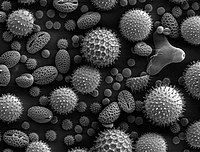
Photo from wikipedia
Microscopy‐image analysis provides precious information on size and structure of colloidal aggregates and agglomerates. The structure of colloids is often characterized using the mass fractal dimension df$d_f$ , which is… Click to show full abstract
Microscopy‐image analysis provides precious information on size and structure of colloidal aggregates and agglomerates. The structure of colloids is often characterized using the mass fractal dimension df$d_f$ , which is different from the two‐dimensional (2D) fractal dimension dp$d_p$ that can be computed from microscopy images. In this work, we propose to use a recent morphological aggregation model to find a relationship between 2D image fractal dimension and 3D mass fractal dimension of aggregates and agglomerates. Our case study is represented by scanning transmission electron microscopy images of boehmite colloidal suspensions. The behaviour of the computed df$d_f$ at different acid and base concentration shows a fair agreement with the results of small angle x‐ray scattering and with the literature, enabling to use the df$d_f$ versus dp$d_p$ relationship to study the impact of the composition of the colloidal suspension on the density of colloidal aggregates and agglomerates.
Journal Title: Journal of Microscopy
Year Published: 2022
Link to full text (if available)
Share on Social Media: Sign Up to like & get
recommendations!